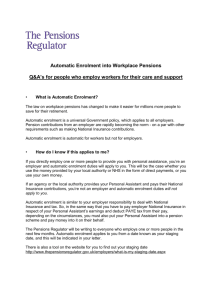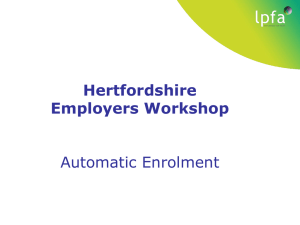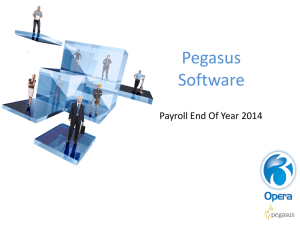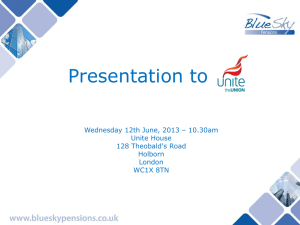Andy Agathangelou-final
advertisement
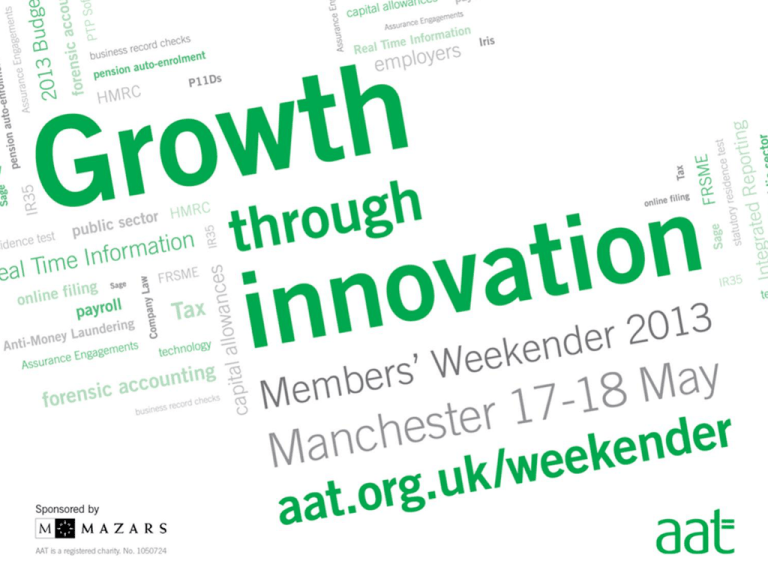
Implementing Auto Enrolment Successfully Andy Agathangelou, Head of Strategic Relationships, Close Brothers Asset Management Auto-enrolment represents a seismic shift in the UK’s pensions landscape The best approach for this session • Interactive workshop format • Let’s focus on the bigger picture, not the nitty-gritty • All the detail is also available here: http://www.thepensionsregulator.gov.uk/employers/detail ed-guidance.aspx • PDF copies available on request Number of people working to every pensioner The background Lord Turner 2003-2006 Chair of the Pensions Commission Main architect of Pensions Reform Fairer and more generous State Pension Low cost pension aimed at low-tomoderate earners Automatic enrolment into workplace pension schemes The New Employer Duties Compulsory minimum employer & employee contributions What are the headline requirements? • To have a Qualifying Workplace Pension Scheme • To auto enrol all eligible jobholders • To ensure contributions meet with minimum requirements • To provide prescribed information to employees • Overseen by The Pensions Regulator • Extensive new powers When do these changes take effect? Number of PAYE staff Staging date 50,000+ Q4 2012 10,000 – 49,999 Q1 2013 4,000 – 9,999 Q2 2013 1,250 – 3,999 Q3 2013 500 – 1,249 Q4 2013 250 – 499 Q1 2014 160 – 249 1st Apr 2014 90 – 159 1st May 2014 62 – 89 1st July 2014 0 - 61 Aug 2014 to Apr 2017 New employers May 2017 to Feb 2018 • Employers can choose to auto enrol from October 2012 or postpone by 3 months from staging date • Employers should start preparing for AE 18 – 24 months prior to staging date To do list • • • • • • • • • • Understand the consequences of non-compliance and the risks Create complete and accurate data Assess your workforce Model the financial impact Establish at least one Qualifying Workplace Pension Scheme Implement Auto Enrolment Communicate compliantly Report as required Re-assess each pay reference period Project manage inclusively Operational risks Stage 1 Warning • Compliance / unpaid contribution notice Stage 2 Wake up call • Fixed penalty £400 Stage 3 Serious / persistent offender • Escalating penalties: • 500 + employees = £10,000 • 250 – 499 = £5,000 • 50 – 249 = £2,500 • 5 – 49 = £500 • 1 – 4 = £50 Per day! Create complete and accurate data • “Auto Enrolment is a data management issue on an industrial scale!” • You cannot require employees to provide you with any information at the point of enrolment - it must be automatic, with no input needed from the employee whatsoever • You therefore need to have all the information you need in advance • You will require much more data than you probably hold at the moment • This step alone may be a substantial and time-consuming task • You will need to report on:• Full employee data • Contracts • Details of your Qualifying Workplace Pension Scheme(s) • Eligibility data • Opt in notices • Membership data • Opt out notices • Contribution payments and dates • Opt out data • Automatic enrolment dates • Individual records Assess your Workforce AE effects full time and part time employees, agency workers, offshore workers and some contractors on payroll • You will have to assess each worker individually • You will have to re-asses every pay reference period • Key challenges: • Who is a worker? • Should you review terms & conditions of • Salary • Eligible jobholders • must auto enrol • must pay contributions agency/contract/temporary workers? • How accurate are HR/payroll records? • How will you deal with spikes in earnings? • Re-assess each pay reference period? • Do you have systems to cope? • Do you have resource to cope? • Who will take responsibility? Non-eligible jobholders • must enable opt-ins • must pay contributions Earnings trigger (£9,440) Entitled workers Lower earnings level (£5,668) • must arrange pension membership • don’t have to pay contributions 16 22 Age SPA 75 Carry out cost modelling to forecast the financial impact • Minimum contribution requirements Phase duration If employer pays minimum Total minimum contribution Employer minimum contribution Employee contribution Tax relief 1 1 Oct 2012 to 30 Sept 2017 2% 1% 0.8% 0.2% 2 1 Oct 2017 to 30 Sept 2018 5% 2% 2.4% 0.6% 3 1 Oct 2018 onwards 8% 3% 4% 1% • Use modelling software to consider various scenarios - How many opt-outs? - How many opt-ins? • What will be the operational cost of handling all the extra administration? - How much of that extra operational cost can technology mitigate? Certification options High variable pay Total pay Moderate variable pay (basic pay> 85% total pay) All pay is pensionable Variable pay £41,450 (UEL) Basic or pensionable pay £5,668 (LEL) Default 8% of Qualifying earnings (min 3% employer) 9% of basic pay (min 4% employer) 8% of basic pay (min 3% employer) 7% of pay (min 3% employer) Establish at least one QWPS Does your existing scheme meet the QWPS requirements? • Does it permit automatic enrolment? • Are all employees enrolled automatically within 3 months of joining? • Does the scheme have a ‘default’ investment option? • Is there a glide path to safer assets as retirement approaches? • Does it recognise the likely characteristics and needs of employees • Is there an appropriate balance between risk & return • Does it meet one of the minimum contribution tests? • Does it have an opt out / opt in facility? Other important considerations: • Will you operate more than one scheme? • What will be the eligibility criteria and scheme rules? • What will be your future contribution structure(s)? • How high is your staff turnover? • Could you somehow link into similar employers using a Master Trust? Why are Master Trusts proving to be increasingly popular? The market generally and employers in particular are becoming increasingly intolerant of ‘yesterdays’ pension offerings:• Defined Benefits Schemes: too expensive and too risky • Occupational Defined Contribution Schemes: too much needless red tape • Group Personal Pensions: inadequate governance Ladbrokes takes punt on Master Trust for AE Pensions Week, December 2012 Standard Life unveils DC master trust pension for employers IFA Online, Sept 2011 The appeal of master trust pension schemes Employee NEST is effectively a master trust! Professional Pensions, Sept 2011 Benefits, July 2012 Master trusts could be making a comeback Employee Benefits, May 2008 Master trusts are rapidly gaining appeal Employee Benefits, January 2012 Implement Auto Enrolment Challenges: • How will you create processes and systems to handle the operational impact? • How will you manage, control and maintain the administration? • How will you create a robust audit trail of what happens at each stage? • How will compliantly inform employees of their right to opt-out? • How will you deal with paying refunds before the scheme refunds you? The full solution processing requirements... Web layer Bespoke Middleware Solution Good technology will be able to handle: • • • • • • • • • • • • • • Scheme suitability testing Financial impact modelling Registering the scheme with The Pensions Regulator Worker assessment Postponement arrangements Pensions protection Multiple payrolls Multiple pay reference periods Complex scheme design Bulk data imports with data assessment and validation Managing opt-outs Managing opt-ins Managing re-enrolment Contributions payment management And… • • • • • • • • • • • • • • • • • • Enabling access to view pension fund details Scheme and member data maintenance Processing of new joiners and leavers Reporting of MI Audit trail of all data changes (and by whom) Compliant records maintenance and archiving Providing for higher levels of data integrity and security Communications through TPR-approved templates (email, SMS, print) Notification of actions (email, SMS, print) Integration with pension provider(s) Integration with payroll provider(s) Integration with The Pensions Regulator Integration with benefit platforms including flexible benefits platforms Handling Salary Exchange arrangements Coping with multiple languages and currencies Re-running reports with historic data for audit and investigation purposes Auto-enrolment administration Providing compliance support in accordance with TPR’s requirements Communicate compliantly • The Pensions Regulator requires you to follow a prescribed format for communications • How will you communicate to all workers? (post, e-mail, SMS text) • How will you communicate effectively? • Effectively, each worker must have an AE audited record • Various communications required include: • postponement notice • assessment • auto enrolment • opt-out • opt-in • re-enrolment Report as required • You will need to be able to report on:• Full employee data • Contracts • Eligibility data • Membership data • Contribution payments and dates • Automatic enrolment dates • Details of your Qualifying Workplace Pension Scheme(s) • Opt in notices • Opt out notices • Opt out data • Individual records • Retain records for up to 6 years (4 years for opt-outs) • The ability to report retrospectively is vital • Your reporting needs to be able to show a robust audit trail Re-assess each pay reference period • Prepare for the on-going operational drag of AE • Systemise all that you can • Leverage technology to the full • Over time, if your systems, processes and technology work well, the situation will normalise, as with many of your existing business functions • Accounts • Payroll • Employee Benefits • Health & Safety • Absence Management, and so on Project manage inclusively Involve HR, Payroll, Finance, Pensions & Benefits, Legal, Advisers, Trustees, Staff Planning 24m-12m Strategy 11m-7m Design 6m-4m Implementation 3m-1m Staging date Capture key data from employer, HR / payroll processes, pay reference periods and contracts of employment (legal input) Assess data and establish costs, identify internal process requirements, data cleansing, agree employee communications, consider key roles and responsibilities Detail project plan, includes review of existing pension arrangement(s) and structure and design of new arrangement(s), start employee communications, consider postponement period Implementation of agreed strategy and design, work with auto enrolment software in parallel with existing processes, implement postponement and optout processes Employee assessment communications if postponement, monitor opt- outs, refunds, opt-ins, register scheme with TPR, compliance record keeping, reenrolment processes Project risks Knowledge Project mgt. Change mgt. Audit Financial Regulatory Capacity Four key areas Data Commercial Fraud Timing Legal Supplier Communications Technology Operational Market capacity issues Don’t delay! Postponement Rules Employers may postpone auto enrolment for up to 3 months • Postponement offers many potential advantages • Postponement defers the assessment of the worker • Can operate different postponement periods for different employee groups • A notice of postponement must be issued to workers • Can be used from the staging date, first day of employment or date worker becomes eligible after staging date • Why might you want to use postponement? • Smooth the process of staging e.g. auto enrol different groups of workers • Align with payroll processes • Smooth process for workers with spikes in earnings • Facilitate contractual joining for salary exchange • Challenges: • There are so many complex factors to consider – should you? If so how? • There are 4 different types of postponement notice! Non Inducement Rules Irrespective of staging date, from July 2012 ensure your processes do not unintentionally fall foul of:• Prohibited recruitment conduct • e.g. asking job applicants if they plan to opt out • Inducements to opt out • Detrimental treatment / unfair dismissal as a result of new employer duties • Actions / omissions which remove Qualifying Scheme status Special considerations for AAT members • Let’s talk through:- • What will be the needs that you can anticipate your clients having? • What resources do you need to be able to assist and guide them? • What will be your approach to their technology requirements? • To what extent do you see AE as a commercial opportunity? • What scope is there for us to work collaboratively? • How would you like us to help you help your clients? Summary and next steps • Auto-enrolment affects every organisation • It is much more complicated than people realise • Planning needs to start now! • We can provide the full range of support services Any questions? For a copy of these slides please: Tel: 0845 450 7897 or Email: ebs@closebrothers.com Thank you! Issued by Close Asset Management Limited (Company No.1644127) which is registered in England and Wales, is authorised and regulated by the Financial Conduct Authority and is a subsidiary of Close Brothers Group plc. Close Asset Management Limited uses the trading name Close Brothers Asset Management. Registered office at 10 Crown Place, London EC2A 4FT Close Brothers Asset Management is a trading name of Close Asset Management Limited and is part of Close Brothers Group plc. Close Asset Management Limited is registered in England and Wales and authorised and regulated by the Financial Services Authority. Registered number: 01644127. Registered office: 10 Crown Place, London EC2A 4FT. VAT registration number: 245 5013 86. •CBAM2020 Auto Enrolment AA version AAT April 2013


